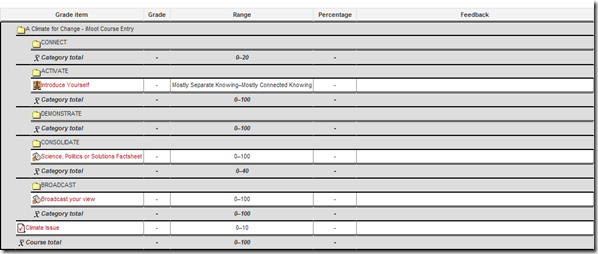Design is personal. One man’s fashion is another man’s faux par and so it is with Moodle course design. There are a number of very good blog posts, screencasts and seminars available, over at Moodlenews there is a category devoted to course formats and it seems to have become a focus of the comprehensive and fantastic iMoot11….
[blackbirdpie id="64751389364076544"]
…however effective course design (style) is of minimal value if not matched by effective learning design (substance). Once past the broad stroke ‘Do’s and Don’ts’ and ‘how to pimp’ your Moodle course, where next? But I am desperately trying to avoid substance of style type response here.
Let me ask you this question…. ‘What were the first Moodle skills you learnt or that were introduced to you?’ And if you are a school leader…. ‘What were the first Moodle skills you shared?’ I am going to hazard a guess at ‘upload a file.’* if you are nodding in agreement, I am going to argue we were wrong and we should have started with the Moodle gradebook. That after you have designed your course, but before you build the learning assets, you should design and then build your gradebook, including the scales and outcomes.
Why the Gradebook?
Building a gradebook requires teachers / educators / facilitators (TEFs) to consider the course in its entirety and how learning will be measured. Gradebook categories then help provide course structure and ‘maximum grade’ assigned to each activity of assignment defines its weighting within the category/course. (Aggregation of items can further refine assessment measures but honestly, wait until you are comfortable with the gradebook, if you are just looking for a total then use ‘sum of the grades.’)With scales and outcomes illustrating and/or informing the marking process your students should understand where or how to improve their work. New learning assets or assignments can be easily added, or left open for improvement, closed or deleted. Hopefully, my persuasive style is winning you over? Without doubt, effective gradebook design will encourage TEFs to consider course substance whilst contributing some structure and the use of feedback, scales and outcomes amplify your learning design.
Why NOT the Gradebook?
There is current a forum discussion over at Moodle.org reviewing the gradebook. It is looking at how internal improvements that might have significant impacts on the gradebook usage. The discussion highlights two points, that Moodle gradebooks are “NOT SIMPLE” and second that TEFs familiarity with Excel impairs their uptake with gradebooks.
Its is encouraging to know that the the changes Moodle HQ are thinking about would bring “useful features for advanced Moodle users while simple usage would remain simple.” Well lets hope simpler still!
IMHO, somehow incorporating into the assignment or activity an ‘add to gradebook YES/NO’ pathway would help manage the gradebook as well as raise its profile. Second, there is an opportunity to raise the profile of the gradebook by showing an assignment submission count or assignment waiting to be graded. A topic I have covered previously.
I am looking forward to the gradebook debate continuing and when the new or improved gradebook will feature?
‘upload a file.’* incidentally I wish I never shared how to upload a file with colleagues. First it just meant I was encouraging staff to use Moodle as yet another shared file repository and second any changes to that document meant downloading, editing and overwriting the original. Quite honestly, a complete waste of time. Simply create a webpage. If the content needs updating, click edit, and change it.
[qr_code_display]


Pingback: links for 2011-05-10 | Kristian Still's Blog